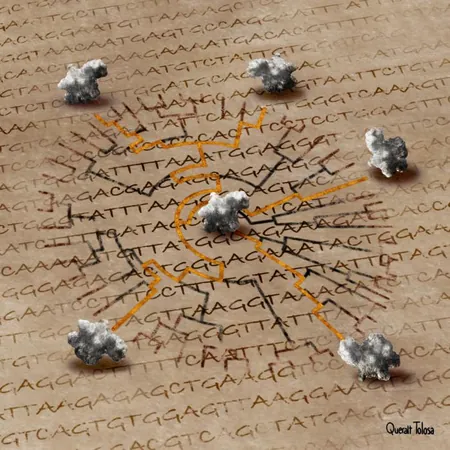
Discover How Combining Protein Structures with Genomic Data is Revolutionizing Our Understanding of Ancient Evolution!
2025-01-15
Author: Rajesh
Groundbreaking Study Unveils Revolutionary Method
A groundbreaking study led by scientists at the Centre for Genomic Regulation (CRG) has just changed the game in evolutionary biology. Researchers have unveiled a method that merges protein shape data with genomic sequences, significantly enhancing the reliability of evolutionary trees—vital tools for scientists tracing the intricate history of life on Earth.
Introducing Multistrap
This revolutionary approach, dubbed “multistrap,” utilizes three-dimensional shapes of proteins to unlock profound evolutionary relationships that have remained elusive. For the first time, this technique effectively employs predicted protein structures, thanks in part to state-of-the-art technologies such as AlphaFold 2, which is generating an unprecedented volume of structural data.
Addressing Data Overload in Biology
In an era when biologists are inundated with information—there are currently over 250 million known protein sequences contrasted against just 210,000 experimentally verified structures—the potential for multistrap to analyze massive datasets is immense. With future projects like the EarthBioGenome aiming to generate billions more sequences, the implications for evolutionary research are astounding.
Overcoming Phylogenetic Challenges
Historically, constructing phylogenetic trees relied heavily on comparing sequences of DNA or proteins. However, this method faced a significant roadblock due to “saturation,” where sequences evolve over long timescales to a point where they lose resemblance to their ancestors. Cedric Notredame, PhD, the lead researcher, likened this phenomenon to the erosion of an ancient manuscript, where the original message becomes indistinct.
Structural Insights into Evolution
The CRG team posited that the physical structures of proteins, known to evolve more slowly than sequences, could provide critical insights. By focusing on intra-molecular distances—measurements that indicate how amino acids within a protein are spaced—they could gauge structural divergence over time, offering a more stable method for tracing evolutionary pathways.
Promising Results from Phylogenetic Trees
The results were promising: phylogenetic trees constructed from shape data were found to closely align with those derived from genetic sequences but were resistant to the effects of saturation. This breakthrough means that researchers can retain reliable evolutionary signals, even in cases where genetic sequences diverged significantly.
The Hybrid Analysis Method
Recognizing the complementary nature of sequences and structures, the team developed a hybrid analysis method named multistrap. This innovative technique combines both types of data, revealing deeper insights into evolutionary relationships. “It’s like having two witnesses recount the same event from different perspectives,” remarked Leila Mansouri, PhD, a coauthor of the study.
Practical Applications in Kinase Studies
One practical application of this research lies in analyzing the complex relationships among kinases, vital proteins that regulate numerous cellular functions. With about 500 protein kinases in the human genome—major targets for cancer therapies—the precision gained through multistrap could enhance our understanding of how these proteins interact and evolve.
Implications Beyond Oncology
But the benefits of this research extend far beyond oncology; they promise to shed light on how diseases evolve, facilitate vaccine development, and even track environmental changes affecting species distribution.
Conclusion
In summary, the fusion of protein structure analysis with genomic sequencing not only enhances our grasp of evolutionary paths but also has the potential to revolutionize medical research and biotechnology. This study is a pivotal step toward unraveling the complexities of life’s evolutionary story—one protein at a time.


 Brasil (PT)
Brasil (PT)
 Canada (EN)
Canada (EN)
 Chile (ES)
Chile (ES)
 Česko (CS)
Česko (CS)
 대한민국 (KO)
대한민국 (KO)
 España (ES)
España (ES)
 France (FR)
France (FR)
 Hong Kong (EN)
Hong Kong (EN)
 Italia (IT)
Italia (IT)
 日本 (JA)
日本 (JA)
 Magyarország (HU)
Magyarország (HU)
 Norge (NO)
Norge (NO)
 Polska (PL)
Polska (PL)
 Schweiz (DE)
Schweiz (DE)
 Singapore (EN)
Singapore (EN)
 Sverige (SV)
Sverige (SV)
 Suomi (FI)
Suomi (FI)
 Türkiye (TR)
Türkiye (TR)
 الإمارات العربية المتحدة (AR)
الإمارات العربية المتحدة (AR)